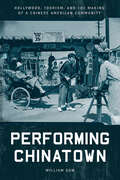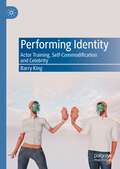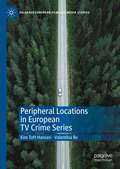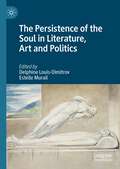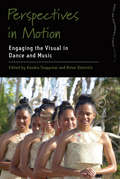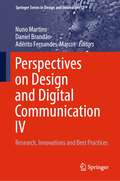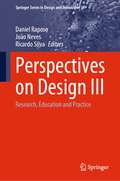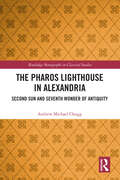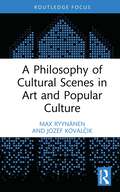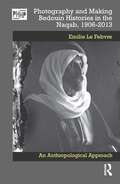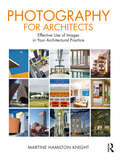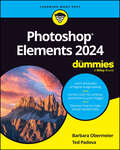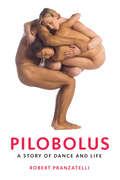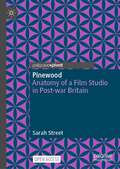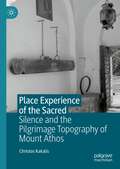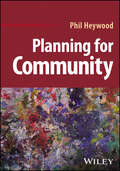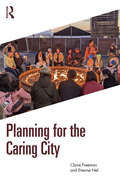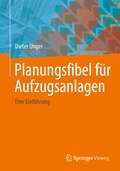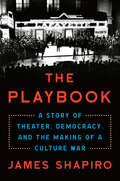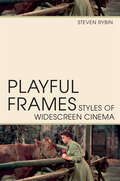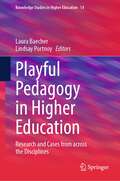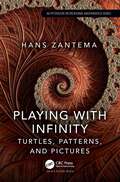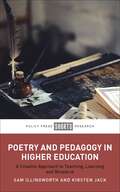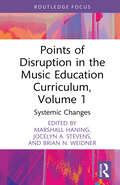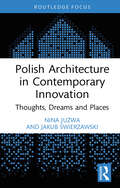- Table View
- List View
Performing Chinatown: Hollywood, Tourism, and the Making of a Chinese American Community (Asian America)
by William GowIn 1938, China City opened near downtown Los Angeles. Featuring a recreation of the House of Wang set from MGM's The Good Earth, this new Chinatown employed many of the same Chinese Americans who performed as background extras in the 1937 film. Chinatown and Hollywood represented the two primary sites where Chinese Americans performed racial difference for popular audiences during the Chinese exclusion era. In Performing Chinatown, historian William Gow argues that Chinese Americans in Los Angeles used these performances in Hollywood films and in Chinatown for tourists to shape widely held understandings of race and national belonging during this pivotal chapter in U.S. history. Performing Chinatown conceives of these racial representations as intimately connected to the restrictive immigration laws that limited Chinese entry into the U.S. beginning with the 1875 Page Act and continuing until the passage of the Immigration and Nationality Act of 1965. At the heart of this argument are the voices of everyday people including Chinese American movie extras, street performers, and merchants. Drawing on more than 40 oral history interviews as well as research in more than a dozen archival and family collections, this book retells the long-overlooked history of the ways that Los Angeles Chinatown shaped Hollywood and how Hollywood, in turn, shaped perceptions of Asian American identity.
Performing Identity: Actor Training, Self-Commodification and Celebrity
by Barry KingThis book examines how the persistent and deepening casualization and precarity of acting work, coupled with market pressures, has affected the ways in which actors are trained in the US and UK. It reviews the existing state of training, looking at various theories of what the actor does, debates about casting, and the impact of reality television and social media. In the increasing effort to find ways to overcome the precarious labour market for actors and other performers, the traditional emphasis on theatrical character has been replaced by the celebration of the persona – a public image of the performer as a personal brand. As a result, a physiocratic elite, that literally incorporates the collective labour of cultural workers into the star or celebrity body, has formed. This book explores how the star or celebrity’s appearance and comportment are positioned as the rule of nature, formed and abiding outside capitalism as a mode of production. This book will be of interest to those studying theatre studies and performance, contemporary stardom and celebrity and the impact of technology on the formation of identity.
Peripheral Locations in European TV Crime Series (Palgrave European Film and Media Studies)
by Kim Toft Hansen Valentina ReThis book is a comprehensive study of peripheral locations in contemporary European TV crime series. Ambitiously, it covers the complete geography of Europe, and offers a nuanced image of a changing, dynamic, and unfinished continent. The chapters include analyses of the practical, creative approach to producing crime series in European peripheries and rural areas, evaluating a continent marked by an internal crisis between urban and rural Europe. The study includes readings of crime series such as Shetland, Bitter Daisies, Trom, Pagan Peak, and The Border, but presents such representative cases within broader tendencies on the European TV market, including challenges from streaming services, the influence of Nordic Noir, and changes within the cognitive geography of Europe. The authors position peripheral European crime series in a complex relationship between universal appeal and local recognisability and offer a comprehensive theoretical approach to the aesthetics of peripherality. Grounded in desktop production studies, the book presents an original scholarly approach to analysing European crime series from a continental point of view. Despite local differences, the spatio-generic orientations scrutinized in the book – Nordic Noir, Mediterranean Noir, Country Noir, Eastern Noir, and Brit Noir – show remarkable aesthetic similarities in series from territories otherwise normally unconnected in television production. Consequently, television crime series reveal a common tongue and voice for dialogue on a continent in a deepening crisis.
The Persistence of the Soul in Literature, Art and Politics
by Delphine Louis-Dimitrov Estelle MurailThis book analyses the evolution of literary and artistic representations of the soul, exploring its development through different time periods. The volume combines literary, aesthetic, ethical, and political considerations of the soul in texts and works of art from the seventeenth to the twenty-first centuries, spanning cultures and schools of thought. Drawing on philosophical, religious and psychological theories of the soul, it emphasizes the far-reaching and enduring epistemological function of the concept in literature, art and politics. The authors argue that the concept of the soul has shaped the understanding of human life and persistently irrigated cultural productions. They show how the concept of soul was explored and redefined by writers and artists, remaining relevant even as it became removed from its ancient or Christian origins.
Perspectives in Motion: Engaging the Visual in Dance and Music (Dance and Performance Studies #15)
by Kendra Stepputat Brian DiettrichFocusing on visual approaches to performance in global cultural contexts, Perspectives in Motion explores the work of Adrienne L. Kaeppler, a pioneering researcher who has made a number of interdisciplinary contributions over five decades to dance and performance studies. Through a diverse range of case studies from Oceania, Asia, and Europe, and interdisciplinary approaches, this edited collection offers new critical and ethnographic frameworks for understanding and experiencing practices of music and dance across the globe.
Perspectives on Design and Digital Communication IV: Research, Innovations and Best Practices (Springer Series in Design and Innovation #33)
by Nuno Martins Daniel Brandão Adérito Fernandes-MarcosThis book gathers new empirical findings fostering advances in the areas of digital and communication design, web, multimedia and motion design, graphic design, branding, and related ones. It includes original contributions by authoritative authors based on the best papers presented at the 6th International Conference on Digital Design and Communication, Digicom 2022, together with some invited chapters written by leading international researchers. They report on innovative design strategies supporting communication in a global, digital world, and addressing, at the same time, key individual and societal needs. This book is intended to offer a timely snapshot of technologies, trends and challenges in the area of design, communication and branding, and a bridge connecting researchers and professionals of different disciplines, such as graphic design, digital communication, corporate, UI Design and UX design.
Perspectives on Design III: Research, Education and Practice (Springer Series in Design and Innovation #34)
by Daniel Raposo João Neves Ricardo SilvaThis book reports on interdisciplinary research and practices in communication, fashion, product, and interior design, highlighting strategies for systematizing the design approach in a global and digital world. It gathers a selection of chapters written by the authors of the best articles presented at the 8th EIMAD conference, on July 07–08, 2022, Portugal. This chapters were chosen considering their particular link to contemporary concerns and challenges, considering the design contribution to health and well-being, social inclusion, sustainable development, design education, and environment and, among others. They cover and bridges between important aspects of design education, research, and practice, as well as creativity and emerging technology, offering a timely perspective and a source of inspiration to researchers, professionals and educators in design, product development and related fields.
The Pharos Lighthouse In Alexandria: Second Sun and Seventh Wonder of Antiquity (Routledge Monographs in Classical Studies)
by Andrew Michael ChuggThis comprehensive and insightful book brings scientific rigor to the problems of reconstructing the Pharos Lighthouse, one of the Seven Wonders of the Ancient World, and understanding how it functioned as the archetypal lighthouse in antiquity, when it was described as a “second Sun”.Conceived by Alexander the Great and designed by Sostratus, the Pharos lighthouse stood as an iconic landmark of Alexandria for sixteen centuries until felled by a calamitous earthquake in the fourteenth century. The study of this great lighthouse has been neglected relative to other ancient Wonders such as the Great Pyramid of Giza. This book reconstructs the tower, its lustrous light, stunning statues and astounding story in diligent detail through archaeological evidence and surviving antique texts and images, providing a fresh evaluation of the Pharos, its history, and its legacy. The Roman writer Achilles Tatius termed the Pharos a “second Sun”; this expression is explained and explored here for the first time, and has dramatic implications for the nature of the Pharos’ light. The volume also explores how the creation of the Pharos was a key stimulus for Alexandrian science and astronomy in antiquity.The Pharos Lighthouse in Alexandria provides a fascinating new study of this monument of interest to students and scholars of Hellenistic art, architecture, and science, and readers seeking to learn more about one of the Seven Wonders of the Ancient World.
A Philosophy of Cultural Scenes in Art and Popular Culture (Routledge Focus on Art History and Visual Studies)
by Max Ryynänen Jozef KovalčikThis book seeks to understand culture through the lens of scenes, analyzing them aesthetically and culturally as well as understanding them through the frameworks of gender, social networks, and artworlds. It is common to talk about the cultural and intellectual scenes of early twentieth-century Vienna, the visual art scene of postwar New York, and the music and fashion scene of the swinging London. We often think about artists and works of art as essentially belonging to a certain scene. Scenes might offer a new approach to study what is possible, what is a tradition, and/or to discuss what are the relevant units of contemporary culture for research. The book posits that scenes explain a lot about how the artworld and the cultural field function. Vivienne Westwood, Rene Magritte, Roman Jakobson, Arthur C. Danto, Susan Sontag, James Baldwin, and Didier Eribon are among the figures included in the book, which examines scenes in cities such as Moscow, Bombay, New York, London, Paris, Brussels, Helsinki, and Bratislava. The book will be of interest to scholars working in art history, cultural studies, philosophy, film, literature, and urban studies.
Photography and Making Bedouin Histories in the Naqab, 1906-2013: An Anthropological Approach (Photography, History: History, Photography)
by Emilie Le FebvreIntroducing a novel anthropological study of photography in the Middle East, Emilie Le Febvre takes us to the Naqab Desert where Bedouin use photographs to make, and respond to, their own histories. She argues Bedouin presentations of the past are selective but increasingly reliant on archival documents such as photographs which spokespersons treat as evidence of their local histories amid escalating tensions in Israel. These practices shape Bedouin visual historicity, that is the diverse ways people produce their pasts in the present with images. This book charts these processes through the afterlives of six photographs (c. 1906–2013) as they circulate between the Naqab’s entangled visual economies – a transregional landscape organised by cultural ideals of proximity and assemblages of Bedouin iconography. Le Febvre illustrates how representational contentions associated with tribal, civic, and Palestinian-Israeli politics influence how images do history work in this society. She concludes Bedouin visual historicity is defined by acts of persuasion during which photographs authenticate alternating history projects. Here, Bedouin value photographs not because they evidence singular narratives of the past. Rather, the knowledges inscribed by photography are multifarious as they support diverse constructions of history and society with which members mediate a wide range of relationships in southern Israel. This book bridges studies of anthropology, photography, Palestinian-Israeli politics, and Bedouin Middle East history.
Photography for Architects: Effective Use of Images in Your Architectural Practice
by Martine Hamilton KnightWe live in a world driven by images, but with so much visual noise, is anyone really looking? How does an architect ensure their portfolio is within view of the right audience? Photographs are still as vital to architectural practice as they ever were. However, creation and circulation, once in the hands of skilled professionals, is now perceived as being ‘free’ and within easy reach of all. But where is the clarity? What is the message? By setting out the case for curated image making, considered photography may again be placed at the centre of architectural marketing strategies. Photography for Architects guides the reader through various topics: from establishing a visual brand and sharing images online, to producing content in-house and commissioning professionals. It explores the still and moving image, creating books and exhibitions for legacy value, compiling award entries, and engaging with trade press. Little understood aspects regarding legal rights and obligations, ethics, copyright, and licensing images for use are discussed in clear language. Multiple photographic examples and conversations with international practitioners highlight the various themes throughout. Written by a working architectural photographer whose life has been spent in commercial practice, this easy-to-read, richly illustrated guide is essential reading for architects and designers alike who are working with images and image makers.
Photoshop Elements 2024 For Dummies
by Barbara Obermeier Ted PadovaGet in touch with your creative side using Photoshop Elements Photoshop Elements 2024 For Dummies covers the newest version of Adobe’s beginner-friendly photo editing software. With the help of this Dummies guide, you’ll discover the ins and outs of Photoshop Elements, so you can transform your images from ordinary to extraordinary. The software is packed with all the photo editing tools you need to turn your images into showstoppers. With the help of the easy-to-understand instructions in this book, you’ll learn how to use the editing tools, utilize layers, make one-click fixes, brighten colors, add filters, and beyond. Get started with Photoshop Elements and make basic edits in quick mode Create different views of an image and use the history panel to find the best version of your image Replace backgrounds, merge photos, and do other neat editing tricks Understand camera raw to turn your camera’s image data into a stunning photo This bestselling Dummies guide is the book you need to get started with Elements and learn the insider tips that will give your images that “wow factor.”
Pilobolus: A Story of Dance and Life
by Robert PranzatelliThe dynamic history of the innovative, beloved, and critically acclaimed dance theater company, with revelatory behind-the-scenes details of its creators and significant works The ingeniously innovative and enduringly popular American dance theatre company Pilobolus has helped redefine, remix, and rejuvenate the essence of dance with its eclectic sensibility and daring athleticism. Now, for the first time, the story of Pilobolus, from its counterculture origins through its pop-culture triumphs and contemporary global acclaim, is revealed in a book that will entrance longtime admirers and newcomers alike. Written with unprecedented access to the company—with insights from unpublished archival materials and interviews with its founders, dancers, and current artistic directors—and featuring both classic and never-before-seen photos, Pilobolus offers previously untold details about the group’s history and the creation of its most significant works. Robert Pranzatelli describes the company's genesis in a Dartmouth dance class in 1971 and how Pilobolus revolutionized dance with its blend of sensuality, physical achievement, and visual wit. In these pages, the troupe performs on Broadway, travels the world, and by the late 1980s secures a place in dance history, while its growth is marked by periods of internal conflict, challenges, and change. As Pilobolus continues to morph, invent, and thrive with the arrival of new artists and collaborators, its story encompasses love, loss, grief, and rebirth, as well as insights into the secrets of the creative process—how performers and choreographers think and work. More than a history, Pilobolus is a narrative of life and art, and the vitality that infuses and inspires both when they align and inhabit each other.
Pinewood: Anatomy of a Film Studio in Post-war Britain
by Sarah StreetThis open access book examines how Pinewood came to be Britain’s dominant film studio complex, focusing on key years following the Second World War. It presents a revisionist, micro history of the studio and its longevity during a particularly turbulentperiod, explaining Pinewood’s survival at a time when other major film studios such as Denham closed. This book also provides contemporary insights into how Pinewood’s technologies, practices, and filmmaking methods compared to Hollywood’s. Thirteen films produced in1946–47 are analysed in detail, tracking how economic pressures engendered many creative techniques and innovative technologies. Prevailing cultures of management and labour organization are foregrounded, as well as insights into being a studio employee. These are vividly brought to life through an in-depthfocus on the in-house studio magazine Pinewood Merry-Go-Round, which provides rare details of sports and leisure activities organized at the studios.
Place Experience of the Sacred: Silence and the Pilgrimage Topography of Mount Athos
by Christos KakalisThis book explores the topography of Mount Athos, emphasizing the significance of silence and communal ritual in its understanding. Mount Athos, a mountainous peninsula in northern Greece, is a valuable case study of sacred topography, as it is one of the world’s largest monastic communities and an important pilgrimage destination. Its phenomenological examination highlights the importance of embodiment in the experience of religious places. Combining interdisciplinary insights from architectural theory, philosophy, theology and anthropology with archival and ethnographic materials, the book brings a fresh contribution to both Athonite studies and scholarship on sacred space. By focusing on the interrelation between silence and communal ritual, it offers an alternative to the traditional art historical, objectifying approaches. It reintroduces the phenomenological understanding of place, investigating also how this is expressed through a number of narratives, such as travel literature, maps and diaries.
Planning for Community
by Phil HeywoodPlanning for Community A comprehensive exploration of community planning that integrates today’s social and economic issues with policy and governance considerations In Planning for Community, distinguished regional and local planner Phil Heywood delivers an insightful examination of the accelerating impacts of social, environmental, and economic changes on community life and organization. He explores the ways in which these changes can be anticipated, planned for, and managed as he reviews and evaluates the nature and challenges of place and interaction faced by traditional and emerging local communities. The book includes discussions of the values, aims, and methods of community planning and the key operations in each of the fields of housing, work, transport, health, and environment. It should also inspire and assist readers to become more involved and influential in the lives of their local and wider communities. Readers will also find: A thorough introduction to methods of inclusion and empowerment enabling effective community management Comprehensive explorations of the ways the values of prosperity, liberty, social justice, and sustainability link to practical community problem-solving Practical discussions of the values, methods, activities, design, and governance shaping community planning Comprehensive, well-grounded, and effective treatments of policy development and practice Planning for Community is an excellent resource for professionals, activists, academics, and students seeking a comprehensive and readable guide to community planning.
Planning for the Caring City
by Claire Freeman Etienne NelAs the world has become increasingly urbanised and planetary well-being ever more threatened, questions have emerged over just what the priorities should be for how we live in cities. Clearly for many the current ways of planning and managing city environments are not working, given so many of their human and non-human inhabitants struggle on a daily basis to maintain their well-being and survival. Different approaches to city development are crucial if they are to be inclusive places where all can thrive. Ensuring that cities are safe and sustainable and provide a level of care for all their residents places a significant mandate on those who manage cities and on planners in particular. This book examines all the parts of the city where care needs to be incorporated, how we plan, create nurturing environments, include all who live there, build sensitively, support meaningful livelihoods, and enable compassionate governance. With planners in mind this book examines why care is needed in the urban environment, and drawing on real world examples examines how it can be applied in an effective and empowering fashion.
Planungsfibel für Aufzugsanlagen: Eine Einführung
by Dieter UngerDie Planungsfibel soll für Architekten und Aufzugsplaner Hinweise geben, was bei der Planung einer Aufzugsanlage in einem Neubau, beim Bauen im Bestand und bei einer Modernisierung zu beachten ist. Die Fibel ersetzt keine Planung, sie soll aber als Hilfestellung dienen, Fehler zu vermeiden. Darüber hinaus soll durch Aufklärung einige im Markt vorhandene Missverständnisse beseitigt werden. Hierbei fließen meine eigenen Erfahrungen ein, die ich bei Planungsvorhaben in der Vergangenheit gewonnen habe.
The Playbook: A Story of Theater, Democracy, and the Making of a Culture War
by James ShapiroA brilliant and daring account of a culture war over the place of theater in American democracy in the 1930s, one that anticipates our current divide, by the acclaimed Shakespeare scholar James ShapiroFrom 1935 to 1939, the Federal Theatre Project staged over a thousand productions in 29 states that were seen by thirty million (or nearly one in four) Americans, two thirds of whom had never seen a play before. At its helm was an unassuming theater professor, Hallie Flanagan. It employed, at its peak, over twelve thousand struggling artists, some of whom, like Orson Welles and Arthur Miller, would soon be famous, but most of whom were just ordinary people eager to work again at their craft. It was the product of a moment when the arts, no less than industry and agriculture, were thought to be vital to the health of the republic, bringing Shakespeare to the public, alongside modern plays that confronted the pressing issues of the day—from slum housing and public health to racism and the rising threat of fascism. The Playbook takes us through some of its most remarkable productions, including a groundbreaking Black production of Macbeth in Harlem and an adaptation of Sinclair Lewis&’s anti-fascist novel It Can&’t Happen Here that opened simultaneously in 18 cities, underscoring the Federal Theatre&’s incredible range and vitality. But this once thriving Works Progress Administration relief program did not survive and has left little trace. For the Federal Theatre was the first New Deal project to be attacked and ended on the grounds that it promoted &“un-American&” activity, sowing the seeds not only for the McCarthyism of the 1950s but also for our own era of merciless polarization. It was targeted by the first House un-American Affairs Committee, and its demise was a turning point in American cultural life—for, as Shapiro brilliantly argues, &“the health of democracy and theater, twin born in ancient Greece, have always been mutually dependent.&”A defining legacy of this culture war was how the strategies used to undermine and ultimately destroy the Federal Theatre were assembled by a charismatic and cunning congressman from East Texas, the now largely forgotten Martin Dies, who in doing so pioneered the right-wing political playbook now so prevalent that it seems eternal.
Playful Frames: Styles of Widescreen Cinema (Techniques of the Moving Image)
by Steven RybinA widescreen frame in cinema beckons the eye to playfully, creatively roam. Such technology also gives inventive filmmakers room to disrupt and redirect audience expectations, surprising viewers through the use of a wider, more expansive screen. Playful Frames: Styles of Widescreen Cinema studies the poetics of the auteur-driven widescreen image, offering nimble, expansive analyses of the work of four distinctive filmmakers – Jean Negulesco, Blake Edwards, Robert Altman, and John Carpenter – who creatively inhabited the nooks and crannies of widescreen moviemaking during the final decades of the twentieth century. Exploring the relationship between aspect ratio and subject matter, Playful Frames shows how directors make puckish use of widescreen technology. All four of these distinctive filmmakers reimagined popular genres (such as melodrama, slapstick comedy, film noir, science fiction, and horror cinema) through their use of the wide frame, and each brings a range of intermedial interests (painting, performance, and music) to their use of the widescreen image. This study looks specifically at the technological underpinnings, aesthetic shapes, and interpretive implications of these four directors’ creative use of widescreen, offering a way to reconsider the way wide imagery still has the potential to amaze and move us today.
Playful Pedagogy in Higher Education: Research and Cases from across the Disciplines (Knowledge Studies in Higher Education #14)
by Laura Baecher Lindsay PortnoyThis collection provides a wide array of concrete and inspiring "playful" approaches to teaching in a range of higher education contexts and discipline areas, grounded in the learning sciences and within a future-oriented revisioning of the university learning environment. Within the broad area of active learning strategies, this text offers a curated collection of creative innovations such as game-based learning, gamification of courses, escape rooms, semester-long quests, dramatic role-plays, artistic endeavors and more. Containing descriptive and impact research that evidences the power of playful pedagogy, this text will offer a range of novel, transferable and usable materials for readers to apply in their lecture halls and classrooms tomorrow.
Playing with Infinity: Turtles, Patterns, and Pictures (AK Peters/CRC Recreational Mathematics Series)
by Hans ZantemaThis is a book about infinity - specifically the infinity of numbers and sequences. Amazing properties arise, for instance, some kinds of infinity are argued to be greater than others. Along the way the author will demonstrate how infinity can be made to create beautiful ‘art’, guided by the development of underlying mathematics. This book will provide a fascinating read for anyone interested in number theory, infinity, math art, and/or generative art, and could be used a valuable supplement to any course on these topics.Features: Beautiful examples of generative art Accessible to anyone with a reasonable high school level of mathematics Full of challenges and puzzles to engage readers
Poetry and Pedagogy in Higher Education: A Creative Approach to Teaching, Learning and Research
by Sam Illingworth Kirsten JackThis book invites us to consider the profound impact that poetry can have in shaping personal and professional development in a higher education setting. Suitable for educators, learners, and practitioners, it offers a transformative learning approach in using poetry for teaching, assessment, research, and reflection. The book includes diverse examples, case studies, and practical exercises, demonstrating poetry's application in personal and professional development in a higher education setting. Each chapter guides readers through these processes, empowering them to integrate poetry into their own teaching and learning practices in a way that is creative, inclusive, and impactful.
Points of Disruption in the Music Education Curriculum, Volume 1: Systemic Changes (CMS Pedagogies and Innovations)
by Marshall Haning Jocelyn A. Stevens Brian N. WeidnerFor decades, scholars in the field of music education have recognized the need for growth and change in our approach to teaching music, yet despite these calls for change, the music education curriculum today remains remarkably similar to that of a century ago. Points of Disruption in the Music Education Curriculum, Volume 1: Systemic Changes is one of two volumes that bring together applied suggestions, analyses, and best practices for disrupting cycles of replication in the curriculum of K-12 and collegiate music education programs in the United States and beyond, considering disruption as a force for positive change. Identifying specific strategies for interrupting or reimagining traditional practices, the contributors provide music teachers and music educators with a variety of potential practical approaches to creating changes that foster a better musical education at all levels of the curriculum.This first volume focuses on systemic changes, including topics like professional development, hiring practices, ableism and universal design, rhizomatic learning, and how to implement disruption across the music education profession. Each chapter contains specific action steps and suggestions for implementation. Bringing together five thought-provoking chapters, this concise volume offers a diverse set of concrete strategies that will be useful to a wide range of music education stakeholders, including teachers, administrators, and curriculum designers.
Polish Architecture in Contemporary Innovation: Thoughts, Dreams and Places
by Nina Juzwa Jakub ŚwierzawskiAuthored by two architects, Polish Architecture in Contemporary Innovation: Thoughts, Dreams and Places tells a story of buildings that were built in Poland between 1980 and 2020, as architecture developed in the Western world and Japan. Its main focus is public utility buildings which the authors “have touched” in situ and which have moved them or sparked their interest. The book is divided into three parts: • Part I focuses on the problem of creating and shaping architectural form and uses examples of both international and Polish architecture. In this section, the authors pose the question: why is the Pritzker Prize so important? • Part II attempts to answer the question of how architecture can change the image of a place. The answer consists of mainly Polish examples of user-friendly architecture, value, and beauty in architecture and place. • Part III analyses buildings that were created in contemporary Poland. Examples are listed in groups, according to their function, pointing out forms that were inspired by the culture of the region, the historical culture of the place, or those which are a new quality and are the foundation of the creation of a place. This book aims to demonstrate Polish architectural solutions in the context of contemporary trends in the West, traditionally seen as more technically and technologically developed countries. The floor plans and sections of the buildings presented in the book show the beauty of geometric and formal solutions and give a new and rare perspective on the latest changes in modern Polish architecture. This book will be of interest to architects as well as researchers and students of contemporary Polish architecture and culture and its place in the European and international context. The Polish edition of this book, published in 2021 by the National Institute of Architecture and Urban Planning in Warsaw, received the Vitruvius Prize 2022 by the Architecture and Urban Planning Committee of the Polish Academy of Sciences.
